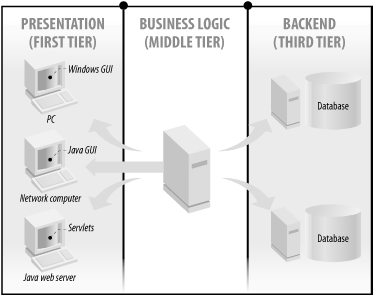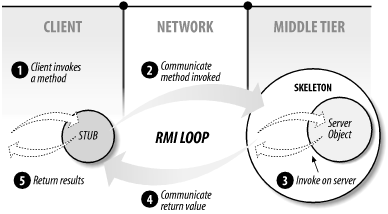To understand EJB, you need to understand how distributed objects work. Distributed object systems are the foundation for modern three-tier architectures. In a three-tier architecture, as shown in Figure 1-1, the presentation logic resides on the client (first tier), the business logic resides on the middle tier (second tier), and other resources, such as the database, reside on the backend (third tier).
All distributed object protocols are built on the same basic architecture, which is designed to make an object on one computer look like itâs residing on a different computer. Distributed object architectures are based on a network communication layer that is really very simple. Essentially, there are three parts to this architecture: the business object, the skeleton, and the stub.
The
business object
resides on the middle tier. Itâs an instance of an
object that models the state and business logic of some real-world
concept, such as a person, order, or account. Every business object
class has matching stub and skeleton classes built specifically for
that type of business object. For example, a distributed business
object called Person would have matching
Person_Stub and Person_Skeleton
classes. As shown in Figure 1-2, the business
object and skeleton reside on the middle tier, and the stub resides
on the client.
The stub and the skeleton are responsible for making the business object on the middle tier look as if it is running locally on the client machine. This is accomplished through some kind of remote method invocation ( RMI) protocol. An RMI protocol is used to communicate method invocations over a network. CORBA, Java RMI, and Microsoft .NET all use their own RMI protocols.[4] Every instance of the business object on the middle tier is wrapped by an instance of its matching skeleton class. The skeleton is set up on a port and IP address and listens for requests from the stub, which resides on the client machine and is connected via the network to the skeleton. The stub acts as the business objectâs surrogate on the client and is responsible for communicating requests from the client to the business object through the skeleton. Figure 1-2 illustrates the process of communicating a method invocation from the client to the server object and back. The stub and the skeleton hide the communication specifics of the RMI protocol from the client and the implementation class, respectively.
The business object implements a public interface that declares its business methods. The stub implements the same interface as the business object, but the stubâs methods do not contain business logic. Instead, the business methods on the stub implement whatever networking operations are required to forward the request to the business object and receive the results. When a client invokes a business method on the stub, the request is communicated over the network by streaming the name of the method invoked, and the values passed in as parameters, to the skeleton. When the skeleton receives the incoming stream, it parses the stream to discover which method is requested, then invokes the corresponding business method on the business object. Any value that is returned from the method invoked on the business object is streamed back to the stub by the skeleton. The stub then returns the value to the client application as if it had processed the business logic locally.
[4] The acronym âRMIâ isnât specific to Java RMI. This section uses the term RMI to describe distributed object protocols in general. Java RMI is the Java language version of a distributed object protocol.
Get Enterprise JavaBeans, Fourth Edition now with the O’Reilly learning platform.
O’Reilly members experience books, live events, courses curated by job role, and more from O’Reilly and nearly 200 top publishers.



